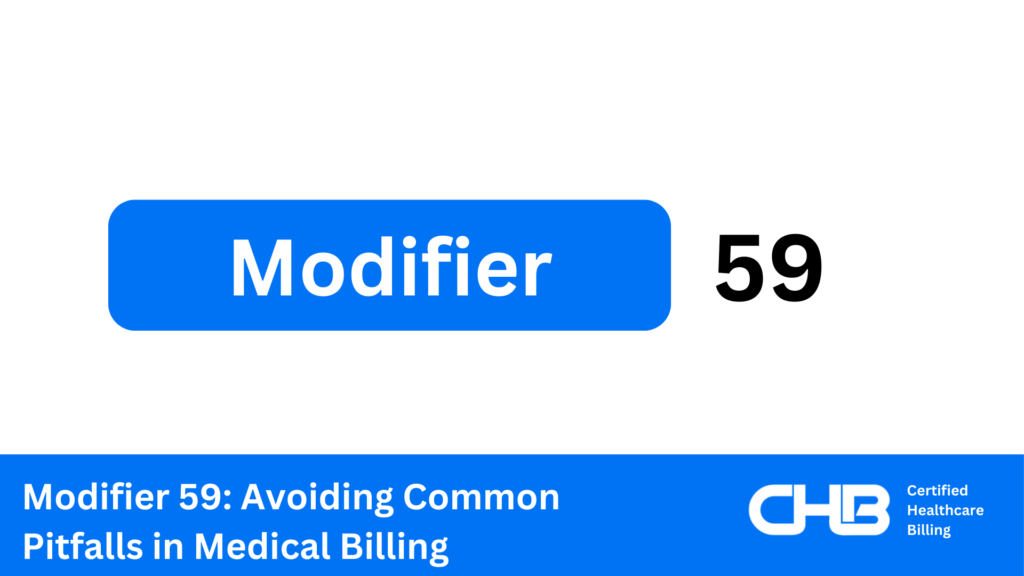Modifier 59 avoiding common pitfalls in medical billing

In medical billing, precision is paramount.
One critical aspect ensuring correct reimbursement is the use of modifiers.
Among these, Modifier 59 plays a vital role.
But what exactly is Modifier 59, and how can it impact your practice’s revenue?
What is Modifier 59?
Modifier 59 indicates that two or more procedures are distinct or independent from one another.
It signals to payers that a procedure should be considered separately from other services performed on the same day.
This modifier is essential for coding multiple services that might otherwise be bundled together.
Using it correctly can prevent denied claims or reduced reimbursements.
When to Use Modifier 59
Using Modifier 59 correctly can prevent revenue loss.
Here are scenarios where it’s appropriate to apply this modifier:
Different Sessions or Encounters
When services are performed in separate sessions on the same day.
For example, if a patient returns later for an unrelated procedure.
Different Anatomical Sites
When procedures are performed on different parts of the body.
For instance, treating a fracture on one limb and removing a lesion on another.
Different Incisions or Excision Sites
When the same type of procedure is performed on different incisions or excisions.
Such as excising multiple skin lesions on different parts of the body.
Separate Injuries or Conditions
When treating distinct injuries or conditions.
For example, addressing a chronic condition and an acute injury during the same visit.
Difference Between Modifier 59 and Modifier 25
While both modifiers indicate distinct services, they apply to different scenarios.
Modifier 59 is used to indicate separate procedures.
Modifier 25 is used to signify a significant, separately identifiable evaluation and management (E/M) service performed by the same provider on the same day as another procedure or service.
For example, Modifier 25 is appropriate when a patient visits for a routine check-up and, during the same visit, the provider also performs an unrelated minor surgical procedure.
Modifier 59, on the other hand, would be used if the provider performs two distinct surgical procedures during the same visit.
Examples of Using Modifier 59
Consider a patient receiving both physical therapy for a chronic condition and a diagnostic test for a new injury.
Without Modifier 59, insurance may bundle these services together, leading to a denial or lower reimbursement.
By appending Modifier 59, each service is recognized as separate, ensuring appropriate payment.
Another example involves performing two surgeries in different areas.
Imagine a surgeon repairing a hernia and removing a gallbladder in one session.
Modifier 59 clarifies these are distinct procedures, not to be bundled into a single payment.
Best Practices for Modifier 59
Accurate and thorough documentation is crucial.
Clearly record the distinct nature of each procedure, including different times, anatomical sites, or conditions treated.
Implement a review process for claims involving Modifier 59 to catch potential errors before submission.
Regular internal audits guarantee compliance and identify areas for improvement.
Common Pitfalls and How to Avoid Them
Overuse or Misuse
Overusing Modifier 59 can trigger audits.
Use it only when procedures are truly separate and distinct.
Lack of Specificity
Avoid using Modifier 59 when a more specific modifier (like those from the -X{EPSU} subset) is appropriate.
These modifiers offer more detailed explanations.
For example, XE (Separate Encounter), XS (Separate Structure), XP (Separate Practitioner), and XU (Unusual Non-Overlapping Service).
Conclusion
Modifier 59 is a powerful tool in medical billing.
It ensures proper reimbursement for distinct services.
By understanding its proper use and adhering to best practices, healthcare providers can optimize their revenue and maintain compliance.
Read More:


